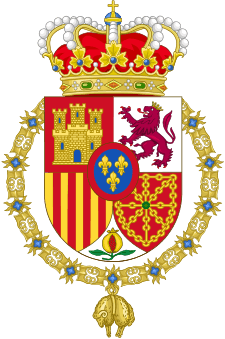Line of succession to the Spanish throne

Spain uses the system of male-preference cognatic primogeniture. Dynasts who marry against the express prohibition of the king and the Cortes are excluded from the succession together with their descendants. A prohibition expressed only by the King or only by the Cortes will have no consequences to the succession. Disputes about the succession are to be settled by legislation.
Line of succession
 King Juan Carlos I (born 1938)
King Juan Carlos I (born 1938)
 King Felipe VI (born 1968)
King Felipe VI (born 1968)
- (1) Princess Leonor, Princess of Asturias (b. 2005)
- (2) Infanta Sofía (b. 2007)
- (3) Infanta Elena, Duchess of Lugo (b. 1963)
- (4) Felipe de Marichalar y Borbón (b. 1998)
- (5) Victoria de Marichalar y Borbón (b. 2000)
- (6) Infanta Cristina (b. 1965)
- (7) Juan Urdangarín y de Borbón (b. 1999)
- (8) Pablo Urdangarín y de Borbón (b. 2000)
- (9) Miguel Urdangarín y de Borbón (b. 2002)
- (10) Irene Urdangarín y de Borbón (b. 2005)
The above list is limited to descendants of King Juan Carlos I; the actual list of successors may be much longer.
Succession uncertainties

Section 1 of Article 57 of the Spanish Constitution provides that "The Crown of Spain shall be inherited by the successors of H. M. Juan Carlos I de Borbón."[1] To date, the Spanish government has not seen fit to clarify whether this provision includes anyone beyond the descendants of King Juan Carlos: "Successors" may not be presumed to be synonymous with "descendants".
King Juan Carlos's two sisters renounced their rights of succession, but those renunciations took place before the adoption of the Constitution and were not ratified by the Cortes as required by Article 57.[2][3] The rights of earlier generations are similarly clouded by numerous renunciations and unapproved marriages which may or may not exclude the individuals involved from the throne.
Article 57 further provides that "Abdications and renunciations and any doubt in fact or in law that may arise in connection with the succession to the Crown shall be settled by an organic act." Article 57 further states that "Should all the lines designated by law become extinct, the Cortes Generales shall provide for succession to the Crown in the manner most suitable for the interests of Spain."
Unless and until an organic act clarifies the rights of other members of the King's family, it is unknown who, if anyone, follows Infanta Cristina's descendants in the line of succession.
Possible interpretations
- If the word "successors" is deemed to mean "descendants", the line ends with Irene Urdangarín y de Borbón.
- If not and if renunciations made by King Juan Carlos's sisters are not deemed valid, Infanta Cristina's descendants are followed by the Duchess of Badajoz and her descendants and the Duchess of Soria and her descendants.
- If not and if renunciations made by King Juan Carlos's sisters are deemed valid, Infante Carlos, Duke of Calabria's heirs follow Infanta Cristina's descendants in the line of succession.
Planned absolute primogeniture
In its 2004 election manifesto, the victorious Spanish Socialist Workers' Party (PSOE) included plans to adopt absolute primogeniture, a proposal which was supported by the leader of the main opposition party, the conservative People's Party. It was initially thought that the change would only apply to future generations but with all the major political parties in agreement that the system of male-preference primogeniture conflicts with the constitutionally established principle of gender equality, it was planned that the law would be changed before the then-Princess of Asturias bore a son, thereby demoting Infanta Leonor to second in line. The subsequent announcement, in 2006, that the Princess was pregnant with a second daughter, however, removed any immediate urgency in the passage of the necessary legislation.
References and notes
- ↑ "La Corona de España es hereditaria en los sucesores de S. M. Don Juan Carlos I de Borbón, legítimo heredero de la dinastía histórica..."
- ↑ de Badts de Cugnac, Chantal; Coutant de Saisseval, Guy (2002). Le Petit Gotha. Paris: Laballery. pp. 419–420. ISBN 2-9507974-3-1.
- ↑ Enache, Nicolas (1999). La Descendance de Marie-Therese de Habsburg, Reine de Hongrie et de Boheme. Paris: ICC. pp. 532–534. ISBN 2-908003-04-X.